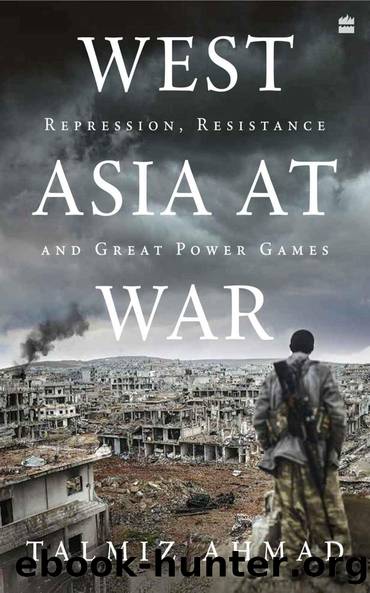West Asia At War by Talmiz Ahmad

Author:Talmiz Ahmad
Language: eng
Format: epub
Tags: null
Publisher: HarperCollins India
Published: 2022-04-17T17:00:00+00:00
8
Iran and Israel: US Policies Over Two Decades (2001â2021)
IN OCTOBER 2003, THEN SENATOR JOE BIDEN SPOKE OF THE BUSH JR administration as the âmost ideological administration in US history, led by neoconservatives who believe that the only asset that counts is our military mightâ. A few years later, in 2007, Ron Paul, then the Republican presidential candidate, noted that it was not the American people who had wanted war in Iraq; it was âa small number of people called the neoconservative [who] hijacked our foreign policyâ.1 Commentator Michael Hirsh, writing in Newsweek in June 2003, said that the neocon vision had âbecome the hard coreâ of American foreign policy. Investigative journalist Seymour Hersh said in January 2005, âThe amazing thing is we have been taken over basically by a cult, eight or nine neo-conservatives have somehow grabbed the government.â2
The neocons, briefly noted earlier, were influential players in the Bush Jr administration and, working closely with the president and his senior officials â Vice President Dick Cheney and Defence Secretary Donald Rumsfeld â shaped and steered US policy in West Asia, impacting, crucially, on its approach to Iraq, Iran and Israel, through the two terms of the Bush presidency.
The Neocon Agenda
The central commitment of the neocons was to Israelâs interests; they successfully projected the view that the interests of the US and Israel were identical. They worked closely with Israelâs politicians and policymakers to define the US position on West Asian issues. As the British writer Patrick Seale has said:
Rightwing Jewish neocons ⦠tend to be pro-Israel zealots who believe that American and Israeli interests are inseparable. ⦠Friends of Ariel Sharonâs Likud, they tend to loathe Arabs and Muslims. For them, the cause of liberating Iraq had little to do with the well-being of Iraqis. ⦠What they wished for was an improvement in Israelâs military and strategic environment.3
After the 9/11 attacks, the neocons grew in stature. They propounded the idea of an extremist Islamic attack on the US that would, according to neocon intellectual Michael Ledeen, bring together âBaathists, radical Wahhabi Sunnis, radical Iranian Shia, and the PLOâ. Ledeen claimed that, while these groups might have differences between themselves, âthey can always put aside their differences whenever there is a common enemyâ; they were united in their hatred of the US because it was the enemy of tyranny which they all represented.4 Ledeen offered no evidence to support these far-fetched assertions, nor did he try to explain how the US, with close ties to authoritarian regimes in Asia, Africa and Latin America, could be viewed as the âenemy of tyrannyâ.
Affirming this monolithic neocon view of the region, Robert Kagan and William Kristol, as early as October 2001, predicted that âAfghanistan will prove but an opening battle. ⦠[This war on terrorism] is going to spread and engulf a number of countries in conflicts of varying intensity. ⦠It is going to resemble the clash of civilisations that everyone has hoped to avoid.â Influential neocons within the administration, such as
Download
This site does not store any files on its server. We only index and link to content provided by other sites. Please contact the content providers to delete copyright contents if any and email us, we'll remove relevant links or contents immediately.
The Bomb, the Bank, the Mullah and the Poppies A Tale of Deception by Iqbal Chand Malhotra(159)
The Political Animal by Jeremy Paxman(157)
The Destiny of Civilization: Finance Capitalism, Industrial Capitalism or Socialism by Michael Hudson(151)
A Secret Order: Investigating the High Strangeness and Synchronicity in the JFK Assassination by H.P. Albarelli(138)
Holtsclaw by H. D. Jacobsen(132)
Chariots of the Desert by The Story of Israeli Armoured Corps(132)
Secret Freedom Fighter: Fighting Tyranny Without Terrorizing The Innocent by Jefferson Mack(131)
Everything You Really Need to Know About Politics: My Life as an MP by Phillips Jess(126)
West Asia At War by Talmiz Ahmad(120)
January 2024 by Le Monde diplomatique(115)
The Law of War and Peace by unknow(110)
Germany and Two World Wars by Egon Harings(109)
The First Dissident by William Safire(106)
America Invulnerable. The Quest for Absolute Security from 1812 to Star Wars by James Chace Caleb Carr(106)
Towards a Socially Sustainable World Economy : An Analysis of the Social Pillars of Globalization by Raymond Torres(97)
Israel in the mind of America by Grose Peter 1934-(95)
The Palgrave Handbook of Global Politics in the 22nd Century by Unknown(93)
Potent natural egg-laying stimulant for cabbage butterfly <Emphasis Type="Italic">Pieris rapae <Emphasis> by Unknown(92)
Napolitano 3 in 1 by Andrew Napolitano(85)
